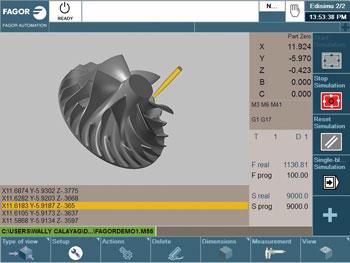- FMA
- The Fabricator
- FABTECH
- Canadian Metalworking
Selecting a New CNC? Look at Every Feature
New control technology simplifies operation, inspections, tool changes
- By Todd Drane
- January 14, 2014
- Article
- Automation and Software

When choosing a new control, such as the Fagor 8065 CNC, look at all of its features. All photos courtesy of Fagor Automation.
Machine operators and programmers are pretty sharp guys. Over the years their feedback has helped to shape new user interfaces for controls.
When choosing a new CNC look at all of the features that could make your difficult tasks easier to perform.
For example, if the operator is taking a break, he needs to be able to shut down the spindle and either jog it or use a manual data input (MDI) function to move it to a safe position. When the operator returns to the machine, a simple auto-return function automatically repositions the axes back to the original position.
Pressing cycle-start will then resume the part program from the point of interruption. This auto-return mode allows the tool to return to the last position in the reverse order the operator pulled out of the part, ensuring no part or tool collisions.
Trying to envision everything an operator might encounter during the execution of a program is a daunting task. However, one task that often is difficult to perform during operation is tool inspection.
In new controls, the tool inspection mode typically is accessed through the program execution mode. By pressing cycle-stop, the operator interrupts the part program and the tool inspection mode becomes available. Now, with the program stopped, he is able to perform new functions.
If the operator interrupts part creation because of spindle chatter or part surface inconsistency, new control technology allows him, while in tool inspection mode, to modify the program for tool wear mid-part. Choosing the tool offset soft key shows the active tool parameters on the screen and allows modification. In addition, at any time during the program execution the operator can adjust feed rate and spindle override to create better part surfaces.
A similar feature to look for in new control technology is the ability to change tools or perform a tool calibration offset directly in the CNC’s tool inspection mode. This allows the operator to either call another tool or set an entirely new tool. After all, operators like to have choices. After a tool change, he can once again return to the original position with auto-return or MDI. This, of course, is convenient when the program is interrupted because of tool breakage.
Look at Every Feature
Some new controls include a new feature called Cancel Continue that allows the operator, while in tool inspection mode, to change the continuation point of the program from the interrupt position. It works like this: After the operator chooses the Cancel Continue soft key, a cursor appears over the program code stop block and allows the operator to scroll forward or backward within the program to choose a new resume-program position. From that point, they can resume the program.
This function comes in handy when a tool is broken because the operator can return to the exact point that breakage occurred.
Another application of the Cancel Continue mode is for very large parts. If an operator is cutting air during the initial roughing passes, he can now stop the program and fast-forward to a new program position, reducing noncutting time and cycle time.
This is similar to retrace functions, which allows operators to interrupt the program and then manually reverse the program to a previous position of up to 75 program blocks.
In today’s manufacturing environment, having the ability to edit/modify the program you are executing also can be important. If management allows this ability, programmers simply name a program with a .mod extension. Any program with this extension can then be modified within execution mode, allowing operators to tweak the part program during the cycle to gain maximum tool performance.
It should also be noted that new CNCs often allow operators to create custom screens, windows, and even pop-ups.
Other features to look for include:
- Simulation mode. New simulation modes on today’s CNCs show the part program graphically, or as main plane commands. Both high-definition solid graphics and conventional tool path line graphics can be available to the operator. The ability to zoom and orient/rotate the part often is a standard graphics mode feature.
- Automatic block search. With a search function an operator can find any point in a program and resume the program from that position in a matter of just a few seconds.
subscribe now


Keep up to date with the latest news, events, and technology for all things metal from our pair of monthly magazines written specifically for Canadian manufacturers!
Start Your Free Subscription- Trending Articles
- Industry Events
MME Winnipeg
- April 30, 2024
- Winnipeg, ON Canada
CTMA Economic Uncertainty: Helping You Navigate Windsor Seminar
- April 30, 2024
- Windsor, ON Canada
CTMA Economic Uncertainty: Helping You Navigate Kitchener Seminar
- May 2, 2024
- Kitchener, ON Canada
Automate 2024
- May 6 - 9, 2024
- Chicago, IL
ANCA Open House
- May 7 - 8, 2024
- Wixom, MI















